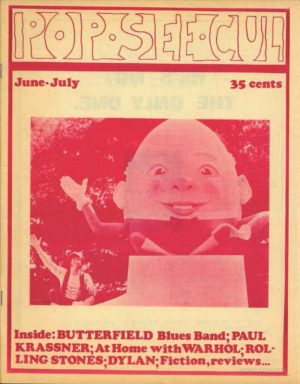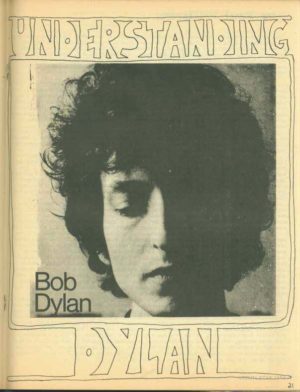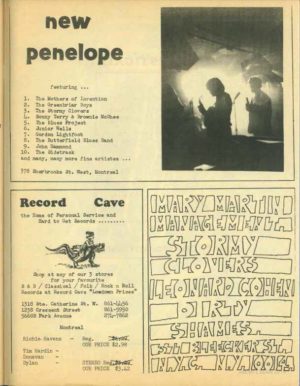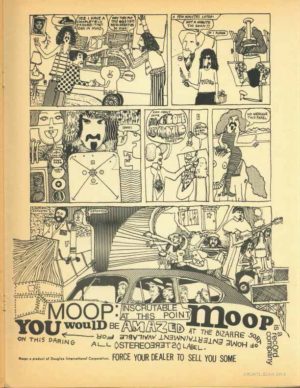Juan Rodriguez Rock Journalist Legend and Pop See Cul zine
AT: Did you go to the first concert in ’65 at the Paul Sauvé?
JR: I certainly did. That’s when I met them. April of ‘65. My friend Simon Schneiderman and I decided to find out where The Stones were staying. Most of the hotels were along what was called then Dorchester Boulevard, and that was about it. But we hit the motel on the corner of Guy and Dorchester. And we had figured, well, you know, they’re not that big, as a matter of fact, in North America, they’re not that big at all. Their biggest hit to date was “The Last Time.” And we figured that they might be at this motel. We tried there, we said we’re looking for The Rolling Stones and the guy behind the desk had this really nervous look on his face, he said “No Stones here.” So, we said, “We’ve hit pay dirt.” We went around the corner and we went to the service entrance just as someone was walking in. And we figured, well what floor do you think they would be on? Probably the top floor. We went up to the top, and they had just arrived and we saw seven doors that were open. You know, like, bits of luggage. Five for The Stones, one for Ian Stuart who was the piano player and roadie, and the other one for Andrew Loog Oldham. Bingo, we hit pay dirt! We went in and chatted with every single one of them, thrilled. We got their autographs.
LR: Do you still have those?
JR: Well, the stupid thing is, I gave the paper with all five autographs on one single piece of paper, which must today go for huge sums, I gave it to my girlfriend.
LR: That’s not too bad, the guy from Logos, remember when he got the “Magical Mystery Tour” film from John Lennon, there was a note saying, “Here you go, good luck with everything, signed John,” so he chucked it in the fireplace right away. It was a different era…
JR: Well yeah, it is like a different era…
LR: They weren’t offended either by having you show up like that?
JR: No, they were fine with it. They were just fine.
LR: They were a bit older than you I guess at that point…
JR: Just a bit. I remember Mick was on his bed reading fan mail, Brian Jones had ordered a drink from the bar service and he took one taste of it and he said, “I said double, you idiot.” And he just kept on combing his hair, looking in the mirror. He was dressed to the nines with two-tone shoes. Bill Wyman was extremely loquacious, very, very nice guy. Did not look like the old stone-face, you know, very nice guy. Charlie Watts was just a little tired, and Keith was trying out his brand new western-style guitar. He had just bought it. And that was the first stop on that tour. And I’m told between Montreal and Toronto, that they wrote “I Can’t Get No Satisfaction.” I’ve been told that by a couple of sources. I’ve read all the accounts. Like I said to Keith while he was strumming, “Hey man, is this all real?” (Laughter) Like a real dorky adolescent. And he said, “Hey, we haven’t come this far without playing for keeps, mate.” Very confident fellow.
LR: Well, it was just really happening for them finally…
JR: What happened right after was “Satisfaction” was definitely a big hit.
LR: Do you think “Satisfaction” had something to do with the Montreal experience?
JR: I don’t know, I’m thinking maybe the ride from Montreal to Toronto wasn’t very satisfying. They had the Sauvé show and then when they came back in October, they were in the Forum, and that’s where the riot broke out. They had to close the lights, they tried everything in the book, girls screaming, rushing the stage like locusts, and it was really exciting. It was really, really something. And the shows that they gave in ’66, they’d come back every year. I was there for the 65 riot. It suddenly turned dark. Dave Boxer came on stage, “Kids, kids, we can’t go on like this,” but when you see pictures from the European concerts, particularly Germany and places like this, it was the same reaction. Kids jumping on the stage and mauling The Stones.
AT: So that’s what the “riot” was, it wasn’t in the streets afterwards, right?
JR: No. That was the riot inside.
LR: Did you go to many shows at Expo in the summer of 67?
JR: At Expo I saw a lot of the shows, I saw Leonard Cohen there. Then I saw Leonard at the New Penelope as a spectator who was looking at Joni Mitchell. And I saw them walk out together. The rumour is true. I was there! I had first met Cohen through Gary Eisenkraft. I had published a book of poetry that I sold at The Record Cave. Cohen somehow was at Gary’s apartment one day and I handed him a copy. He looked at it studiously and says, “Hey man, this is really good.” So it was very encouraging. Early on Leonard was in an occasional country band called The Buckskin Boys, but I think the motivation that got him into music was when he saw Bob Dylan, and hitting the charts like crazy. He said “This is the way to make big bucks.” Because you don’t make any money on these poetry volumes. Maybe he’s made some money since on those, but it was a drop in the bucket compared to this huge record industry.
LR: He ended up at Columbia, the same label as well…
JR: Yup. He had the same manager, Mary Martin, that managed this band that used to play at The Penelope, The Stormy Clovers. And that was his in. That was his connection.
AT: I heard that they were the first band to actually record “Suzanne,” so he must’ve been like, “Oh yeah, I could go into this medium and do well with it without a band.
JR: Absolutely. The first review I did of him, I just totally slammed him. I remember it extremely well, it was at the Théatre St-Denis, I think it was 1970, and the mood was so reverent, sickeningly reverent– like along the stage they had put candles, you know, it was like going into St-Joseph’s Oratory except it was a show. And he had his country band with him, with Bob Johnson and the boys, I thought that he just droned and droned and droned. So my review was something like “It made me pine for Roy Rogers and Dale Evans to add some pep to this country music.” That time, he had stayed over in Montreal. There was this coffee place owned by Sidney Rosenthal on Crescent Street where Ziggy’s is now, and I got the word that Leonard wanted to meet me. That was right after the review, he was absolutely furious. So I walked in and he was there, saying “That wasn’t a review, it was gutter talk,” and I said, “Come on, Leonard, I thought it was kind of funny.” He says, “You know, my band’d like to beat you to a pulp.”
LR: Was he visibly angry?
JR: Visibly angry. He was trying to keep cool, but he was talking very loudly. Years later, he told me that he was so pissed off because his mother asked him, “Leonard, how come you’re getting so many bad reviews in Montreal?” (Laughter).
DD: Oh, just what you want to hear from your Jewish mother.
JR: And it was really only in 1988 when he put out “I’m Your Man,” when he embraced the electronic thing with those cheap synthesizers, I thought that was a great album, I still think it’s one of his best albums. That’s when I turned.
DD: You didn’t like his Phil Spector stuff? You’re such a Phil Spector fan.
JR: I like it, but I did an interview with him at that time and he said “I don’t know what to think about this album, it’s either a really great album or a really shitty album.” We got into the whole thing about Spector putting the gun to his head, waving the bottle of Manischewitz wine in one hand, as he drank and waved the gun around, making the musicians wait and wait and wait and wait. That was part of his secret, the musicians would be so on edge that when they finally got the word go, they would play their hearts out, just to get it over with. In a way I’m sure that’s what happened when Spector shot that girl, it became like Hollywood. He was probably playing around or something and, “Oops.” And Leonard tells me “Phil was saying, ‘Hey man, I love you’” And he said, “Oh, I sure hope you do, I sure hope you do, Phil, I sure hope you do.” (Laughter).
LR: Do you recall when “Suzanne” hit big, was there a sense of local pride?
JR: Oh, absolutely.
LR: Although it didn’t exactly lead to a whole lot of other local singers making it big…
JR: No, it was very, very difficult to imitate Leonard. I remember at the New Penelope, a guy that impressed me because he was so bad-tempered, was Gordon Lightfoot. And he played the original Penelope on Stanley Street. He had a very hardened face and I recall him as being very intense and very good. Not in that quote-unquote hippie-dippy intense way where every single word “means” something. Lightfoot had the very well-recorded songs, and it’s funny because, Bob Dylan, when he came out with that album “Self Portrait,” he had a couple of Gordon Lightfoot songs. “Early Morning Rain” was on that. Lightfoot, I think, has a sense of his own worth, he was sort of really pissed off to be playing in this tiny, little club and just wanted to get it over with. But, you know, he was a presence that I thought was quite something. I think he was frustrated at that point that he couldn’t get past Yorkville Avenue… People had to get into the States, had to break out of this limited Canadian market, and just finally get contracts and signings, management and all that stuff. So it would’ve been a step down playing, what was it, not even a hundred-person place?
DD: Were you too young to go to the earlier Eisenkraft clubs?
JR: Yeah, there was The Fifth Amendment. I saw The Lost City Ramblers, The Greenbriar Boys, Sonny Terry and Brownie McGhee. It was just a kind of a “space,” today you call them a “loft space,” with a stage. Pete Seeger, I saw him, because my parents were in tight with the Gessers, we would get tickets to see Pete Seeger every single year that he came, and he always played the same venue, Her Majesty’s Theater, which is now the Guy Metro Station.
AT: The Fifth Amendment didn’t serve alcohol, did it …
JR: Right.
AT: From what I heard, Gary Eisenkraft, no matter what he tried to do, could never get a liquor permit…
JR: No, he couldn’t.
LR: Of course there were always places like the Swiss Hut to pop into for alcohol if necessary. What was the scene like there?
JR: You had separatists, lots of them; you had gadflies, like Nick Auf der Maur. And when Zappa came to Montreal for a two-week span in January of 1967, they were in the middle of this long residency at The Garrick Theater in New York, Gary Eisenkraft managed to book him at the New Penelope (next door to the Swiss Hut) for two weeks at the beginning of January ’67, and it was freezing. You can imagine all these people from L.A…. He wore this big raccoon coat, which of course was one of Zappa’s props, there’s tons of pictures of him in that raccoon coat, but that time he really had to use it to keep warm. Now, across from the New Penelope, there was a Banque Nationale, which is still there, and Zappa would ask me to come with him so that he could cash his checks.
LR: To vouch for him?
JR: Yeah, to vouch for him, that he was the real deal. And then they would retire to the Swiss Hut with Don Preston, Bunk Gardner, Jimmy Carl Black, they would go and have the breakfast or brunch. And I’d be able to sit there with them– I mean, Zappa was my hero, and still is… He was great composer of all kinds of music, and one of the great social satirists of the century. There’s no question about it.
LR: That was really early, around his first LP.
JR: Yeah and Frank told me very, very proudly that Freak Out was the first underground album that was distributed in Los Angeles supermarkets.
LR: Did you have that record when it came out, or did you know of them just reading through magazines…
JR: I had the record. Frank was very encouraging because I did a column at the time for the Sir George Williams University paper, now Concordia– even though I had dropped out, I still wrangled a column there once a week. I once wrote the same column for both The Georgian and the McGill Daily, railing against the New Left. Even though I am a leftist all the way, I didn’t like some of the tactics and stupidities that were going on.
LR: What about the Sir George affair, did you write anything during that?
JR: The famous computer riot. I wrote about that for The Montreal Star, editorial page. I did two pieces, and the first one was called Against the New Left. And some of my lefty friends — and I am a died-in-the-wool socialist, always will be — said “Juan, you shouldn’t have done that; it’s like writing an anti-Israeli piece in an Arab newspaper.” And I said, “Yeah, exactly.” (Laughter).






Comments